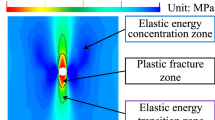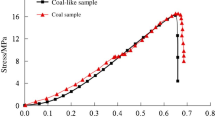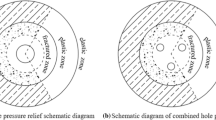Abstract
Drilling cutting method is a common method to predict rock burst based on the quantitative relationship between drilling cuttings and coal body stress, but it is restricted by some factors in mining process. The drilling depth is failure to reach the stress concentration area, the drilling cuttings can not reflect the stress accumulation area and can not predict the rock burst effectively. In order to overcome the limitation and lag of drilling cuttings, the improved drilling cutting method based on drilling cuttings and its variation is proposed. Taking the No. 3302 working face of Xingcun Coal Mine as the engineering background, the improved drilling cutting method is applied. And the result of the the improved drilling cutting method is consistent with the results of field microseismic monitoring. The obtained results show that the improved drilling method can improve the predicted capabilities of the rock burst and provide a novel insight to prevent the occurrence of rock burst.












Similar content being viewed by others
References
Cao YX, Davis A, Liu RX et al (2003) The influence of tectonic deformation on some geochemical properties of coals-a possible indicator of outburst potential. Int J Coal Geol 53(2):69–79
Casten U, Fajklewicz Z (2010) Induced gravity anomalies and rock-burst risk in coal mines: a case history. Geophys Prospect 41(1):1–13
Chen XH, Li WQ, Yan XY (2012) Analysis on rock burst danger when fully-mechanized caving coal face passed fault with deep mining. Safety Sci 50(4):645–648
Cheng YH, Jiang FX, Hu ZF et al (2016) Prevention and control of coal burst on gob-side entry in deep coal seam with fully mechanized sublevel caving mining. Chin J Rock Mech Eng 35(S1):3000–3007
Dou LM, He XQ, He H, Jiang He et al (2014) Spatial structure evolution of overlying strata and inducing mechanism of rockburst in coal mine. T Nonferr Metal Soc 24(4):1255–1261
Feng GL, Feng XT, Chen BR et al (2015) A microseismic method for dynamic warning of rockburst development processes in tunnels. Rock Mech Rock Eng 48(5):2061–2076
Gu ST, Wang CQ, Jiang BY et al (2012) Field test of rock burst danger based on drilling pulverized coal parameters. Disaster Adv 5(4):237–240
Hajiabdolmajid V, Kaiser PK, Martin CD (2002) Modeling brittle failure of rock. Int J Rock Mech Min 39(6):731–741
Li XH, Pan F, Li HZ et al (2016) Prediction of rock-burst-threatened areas in an island coal face and its prevention: a case study. Int J Min Sci Technol 26(6):1125–1133
Lu YY, Liu Y, Li XH et al (2010) A new method of drilling long boreholes in low permeability coal by improving its permeability. Int J Coal Geol 84(2):94–102
Lu CP, Dou LM, Zhang N et al (2013) Microseismic frequency-spectrumevolutionary rule of rockburst triggered by roof fall. Int J Rock Mech Min Sci 64:6–16
Lv JG, Jiang YD, Zhao YX et al (2013) Hierarchical monitoring for coal bumps and its study and application of early warning methods. J China Coal Soc 38(38):1161–1167
Pan YS, Ling ZH, Zhang MT (2003) Distribution, type, mechanism and prevention of rockbrust in china. Chin J Rock Mech Eng 22(11):1844–1851
Pan JF, Mao DB, Xia YX et al (2012) Probing into the main occurred areaand period of rockburst based on precursory monitoring of associ-ated factors. Chin J Rock Mech Eng 31:1650–1656
Qu XC, Jiang FX, Yu ZX et al (2011) Rockburst monitoring and precaution technology based on equivalent drilling research and its applications. Chin J Rock Mech Eng 30(11):2346–2351
Tan YL, Yin YC, Gu ST et al (2015) Multi-index monitoring and evaluation on rock burst in yangcheng mine. Shock Vib 2015:(2015-5-21) 2015(2), 1–5
Tanaino AS, Lipin AA (2004) State and prospects of the percussive-rotary blasthole drilling in quarries. J Min Sci 40(2):188–198
Wolf KA, Bergen FV, Ephraim R et al (2008) Determination of the cleat angle distribution of the recopol coal seams, using ct-scans and image analysis on drilling cuttings and coal blocks. Int J Coal Geol 73(3):259–272
Xie HP, Peng RD, Ju Y (2004) Energy dissipation of rock deformation and fracture. Chin J Rock Mech Eng 23(21):3565–3570
Yan P, Zhao ZG, Lu WB et al (2015) Mitigation of rock burst events by blasting techniques during deep-tunnel excavation. Eng Geol 188:126–136
Yin GZ, Li XQ, Zhao HB et al (2010) In-situ experimental study on the relation of drilling cuttings weight to ground pressure and gas pressure. J Univ Sci Technol Beijing 32(1):1–7
Yu Z, Jiang F, Qu X et al (2011) Study on real-time monitoring and pre-warning system of rock burst based on equivalent drilling cuttings quantity. Achievements and Ambitions, Rock Mechanics, pp 895–899
Zhai C, Xu JZ, Liu SM et al (2018) Investigation of the discharge law for drill cuttings used for coal outburst prediction based on different borehole diameters under various side stresses. Powder Technol 325:396–404
Zhang MT, Xu ZH, Pan YS (1991) A united instability theory on coal (rock) burst and outburst. J China Coal Soc 04:48–53
Zhao YX, Jiang YD, Wang T et al (2012) Features of microseismic eventsand precursors of rock burst in underground coal mining with hardroof. J China Coal Soc 37(12):1960–1966
Zhao GB, Wang DY, Gao B et al (2016) Modifying rock burst criteria based on observations in a division tunnel. Eng Geol 216:153–160
Acknowledgements
This research was supported by the National Natural Science Foundation of China (No. 51604100).
Author information
Authors and Affiliations
Corresponding author
Additional information
Publisher's Note
Springer Nature remains neutral with regard to jurisdictional claims in published maps and institutional affiliations.
Rights and permissions
About this article
Cite this article
Shan, Q., Qin, T. The Improved Drilling Cutting Method and Its Engineering Applications. Geotech Geol Eng 37, 3715–3726 (2019). https://doi.org/10.1007/s10706-019-00863-8
Received:
Accepted:
Published:
Issue Date:
DOI: https://doi.org/10.1007/s10706-019-00863-8




